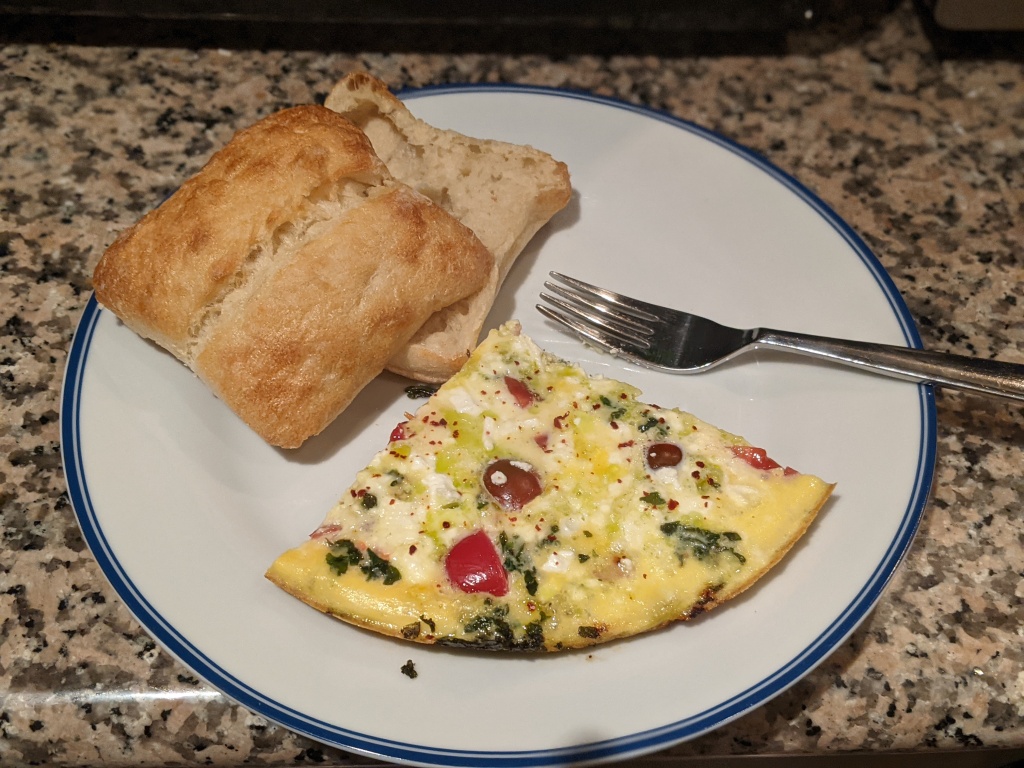I can’t say that ancient cuisine sounds particularly exciting, even for someone like me. But I was surprised earlier this week when, after watching this video from the Historical Italian Cooking research group, I felt inspired to make a variation on an ancient Roman frittata.
I think frittatas are often kind of overblown, since they’re usually just boring omelets. But during my first trip to Sicily in 2016, my dig colleagues changed my mind. During lunch one day, the archaeologist leading the project, who is Roman, made us a simple frittata with zucchini and eggplant (also one of the only times I’ve actively enjoyed those vegetables). We ate it in big slices on good bread with local Sicilian pecorino (a hard cheese somewhere between cheddar and parmesan but less salty than either) and fresh tomatoes. Since then, I’ve come to appreciate frittatas as an opportunity to showcase fresh vegetables and get the same kind of texture in an omelet that I enjoy in a fried egg.
What jumped out at me about the ancient-style frittata was the unusual step of preparing an herb sauce to be added in the middle of cooking. French omelets tend to be the standard for egg preparation here in the US (though thankfully that’s changing), and those are typically made with delicately minced herbs and barely cooked eggs. But this frittata’s herb sauce uses pulverized herbs and garlic, bringing out their strong flavors and then intensifying them by adding wine and garum (Roman fish sauce). This herb sauce is then added to the cooked vegetables before the eggs, which allows it to flavor the whole frittata, avoiding the whole blandness issue.
Since I was making this on a weeknight after my kids had already gone to bed, I was working only with what I had. That didn’t include fish sauce, since I haven’t done a lot of either Southeast Asian or ancient Roman cooking. Instead, I crushed the garlic and herbs with salt and pepper, and then added red wine vinegar to loosen the paste. I did this in a mortar and pestle, but you can use a blender, food processor, or even the side of your knife. I used frozen kale instead of mustard greens, which I particularly like to keep around because I find the texture really nice if I add it to soup or mac’n’cheese – somehow less stringy and aggressively flavored than spinach – and it breaks up really easily while it’s frozen, so I don’t have to chop it before adding it to the pan. I should say, I don’t buy frozen kale, I buy a big bag of salad kale and stick it in my freezer – it’s not as space efficient, but it’s easier to use and cheaper.
For the herbs, I used sage and chives. I recently made myself a window herb box using the herbs you can buy in the supermarket that still have their roots attached. I don’t use sage that much because it’s such a strong flavor, and chives grow back really quickly, so those were the two I had a bunch of. It was a great combination, the sage was really an amazing flavor in this. Finally, I added tomatoes and feta on top. Tomatoes wouldn’t be in any kind of ancient European dish because they didn’t exist in Europe before the 16th century, but I had a bunch of cherry tomatoes lying around and I really like warm tomatoes and eggs. And feta, well …. cheese is delicious, and feta is great in eggs because it’s salty and watery, so it helps flavor the eggs and keep them fluffy. I also threw on some Aleppo pepper at the end (again, a crop that didn’t exist in Europe or Asia before the 16th century) instead of black pepper because I like the spice and the fruity flavor.
Harkening back to my time in Sicily, we ate the frittata on chewy rolls, and it was incredible.

Roman Frittata
Coat the bottom of a medium-sized nonstick pan in olive oil and place over medium-low heat. Add a few large handfulls of chopped kale or other bitter green, and about 1/4 cup of shredded chicken or turkey. Cook, tossing occasionally, until the greens are reduced and the bottom of everything starts to brown. Meanwhile, crush together 2 cloves of garlic, 5 or so sage leaves, 10 or so sprigs of chives, 1 tsp coarse salt, and 1/2 tsp ground black pepper, until the garlic is completely broken up and a thick paste has formed. Add 2 tbsp red wine vinegar and stir to thin out the paste. Set aside. Beat together 6 eggs, set aside. Chop into large chunks about 1/2 cup ripe tomatoes, set aside. Add the herb and vinegar mixture to the greens and meat in the pan and toss to distribute, then immediately add the eggs on top, then evenly distribute the tomatoes over the eggs, and finally crumble a handful of feta over that (you want a fairly moist feta that has been packed in water). Cover the pan and turn the heat to low, then allow to cook for 10 minutes or so. Resist the urge to check on it, because you need the hot air and steam to stay in the pan to cook the eggs. The frittata is done when the surface is set. Slide the frittata out of the pan, sprinkle with 1/4 tsp of Aleppo pepper (or another dried hot pepper powder), and slice. Serve with chewy bread.

[…] Eat eggs like the ancient Romans — Robin Writes Advertisements […]
LikeLiked by 1 person
Looks good!
LikeLiked by 1 person